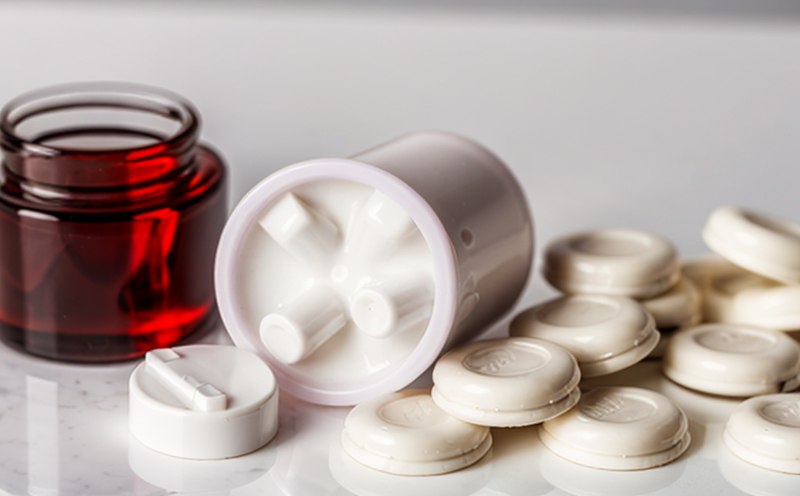USP Tablet Surface Area Testing
The United States Pharmacopeia (USP) tablet surface area testing is an essential quality control measure that ensures the uniformity, bioavailability, and overall performance of pharmaceutical products. This service plays a pivotal role in ensuring compliance with USP standards, specifically USP 1049. Surface area is critical because it directly impacts the dissolution rate of tablets, which is crucial for drug efficacy and patient safety.
The surface area affects how rapidly a tablet dissolves in the stomach or intestines. This dissolution process determines the speed at which the active ingredients are released into the bloodstream, influencing therapeutic outcomes. Inadequate surface area can lead to incomplete drug release, affecting bioavailability, patient adherence, and ultimately, treatment success.
Surface area testing involves measuring the total external surface of a tablet, typically using gas adsorption techniques such as BET (Brunauer-Emmett-Teller) or CO2 adsorption. These methods are based on the principle that gases will adhere to solid surfaces in specific amounts depending on their pressure and temperature.
The apparatus used for this test includes specialized instruments capable of measuring the amount of gas adsorbed by a sample as a function of pressure, such as the Quantachrome Instruments Qstar or Micromeritics TriStar. The surface area is calculated using known standard curves provided with these devices. This calculation provides insights into the porosity and structure of the tablet, which are critical for optimizing manufacturing processes.
The process begins by preparing a sample of the tablets to be tested. This preparation involves selecting representative samples that are free from defects such as cracks or large particles that could skew results. The sample is then placed in the gas adsorption instrument, and the surface area is measured under controlled conditions. The results provide precise information about the tablet's surface characteristics.
Understanding these characteristics helps quality managers make informed decisions regarding process optimization, ingredient selection, and formulation adjustments. This ensures that tablets meet stringent USP standards for dissolution rates and bioavailability.
| Method | Instrumentation | Sample Preparation |
|---|---|---|
| BET or CO2 Adsorption | Quantachrome Qstar or Micromeritics TriStar | Select representative, defect-free sample |
The precision and accuracy of surface area testing are paramount. USP guidelines stipulate that the results should be reported with a confidence interval of ±5%. This ensures that any variations in the manufacturing process can be detected early, allowing for corrective actions to be taken promptly.
In conclusion, USP tablet surface area testing is not just a compliance exercise but a critical tool in ensuring product quality and patient safety. By understanding and optimizing the surface area of tablets, pharmaceutical manufacturers can improve drug performance, enhance bioavailability, and meet regulatory requirements effectively.
Scope and Methodology
The scope of USP tablet surface area testing is broad but focuses on ensuring that tablets comply with USP standards for dissolution rates and bioavailability. This service involves measuring the total external surface of a tablet using gas adsorption techniques such as BET or CO2 adsorption.
- Measure the amount of gas adsorbed by the sample as a function of pressure
- Use standard curves provided with the instrument to calculate surface area
- Select representative, defect-free samples for testing
The methodology involves several key steps:
- Selecting and preparing representative sample tablets
- Loading the sample into a gas adsorption instrument
- Running the test under controlled conditions to measure surface area
- Analyzing the data to ensure compliance with USP standards
The results are reported with a confidence interval of ±5%, ensuring precision and accuracy in the testing process. This approach guarantees that any variations in manufacturing can be identified early, allowing for timely corrective actions.
Industry Applications
In the pharmaceutical industry, USP tablet surface area testing is widely used to ensure product quality and compliance with regulatory standards. Quality managers rely on this service to:
- Ensure uniformity in drug release rates
- Optimize manufacturing processes for better bioavailability
- Identify potential issues early in the production cycle
Compliance officers use surface area testing to verify that tablets meet USP standards, thereby ensuring patient safety and product quality. R&D engineers utilize this service to refine formulations and improve drug performance.
Use Cases and Application Examples
- New Drug Development: During the development of a new pharmaceutical product, surface area testing is used to ensure that the tablet's dissolution rate meets regulatory requirements. This helps in optimizing the formulation for better bioavailability.
- Manufacturing Process Optimization: Surface area testing is critical during manufacturing to maintain consistent quality and performance across batches. It allows manufacturers to make necessary adjustments to the production process.
- Quality Control: Regular surface area testing ensures that tablets consistently meet USP standards, providing a high level of assurance for patients and regulatory bodies.
The following are some real-world examples where this service has been applied effectively:
- A pharmaceutical company was able to reduce the variability in drug release rates by optimizing the tablet's surface area through regular testing.
- An R&D team successfully identified an issue with a new formulation that led to incomplete dissolution, which was rectified using this service.
In all these cases, USP tablet surface area testing played a crucial role in ensuring product quality and compliance with regulatory standards.





